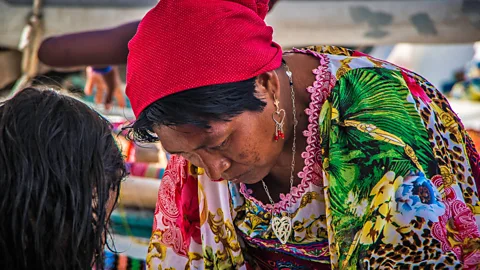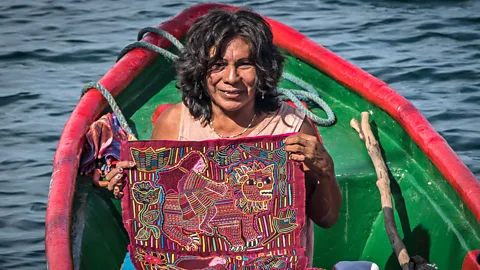Guna Yala: The islands where women make the rules (original) (raw)

 Paul Stewart
Paul Stewart
Women in Guna Yala enjoy an elevated status (Credit: Paul Stewart)
In the small indigenous territory of Guna Yala off Panama’s eastern coast, a flourishing ‘third gender’ community is defying stereotypes – and venerating women.
Our Unique World
Our Unique World explores distinctive subcultures around the globe in celebration of what makes us different.
Check back each week in August and September to discover a new, unique world.
As our old, rickety sailboat glides effortlessly over the calm waters of the Caribbean, I am overwhelmed by the feeling we’ve just arrived in paradise. Scattered across the turquoise blue waters, the tiny islands of glistening white sand, covered in palm trees and green coconuts, look too perfect to be real.
This is Guna Yala, also known as San Blas: an archipelago off Panama’s eastern coast that contains more than 300 islands, 49 of which are inhabited by the indigenous Guna people. More than 50,000 strong, the Gunas still live as their ancestors did, dwelling in small wooden shacks covered with palm leaves, with logs smouldering in the fireplaces and hammocks representing the only furniture.
Guna Yala is extraordinary in many ways: it is an autonomous indigenous territory, and its flag sports a black, left-facing swastika, said to represent the four directions and the creation of the world. But perhaps the most curious tradition in Guna Yala is its natural gender equality – and complete tolerance, if not celebration, of gender fluidity.

 Paul Stewart
Paul Stewart
The Guna Yala archipelago off Panama’s eastern coast is inhabited by the indigenous Guna people (Credit: Paul Stewart)
“My mother taught me how to make these beautiful molas, our traditional embroidered clothes,” Lisa said, showing me her amazing needlework. “Some of these represent birds and animals, but some are very powerful – they will protect you from evil spirits,” she added, smiling softly.
For an onlooker like me, there isn't anything unusual about Lisa. Much like many other Guna women, she’s sitting in her small dug-out canoe and offering her beautiful handicrafts to tourist boats. Except Lisa was born a boy. In a society where women are the main food distributors, property owners and decision makers, boys may choose to become Omeggid, literally ‘like a woman’, where they act and work like other females in the community.
This ‘third gender’ is a completely normal phenomenon on the islands. If a boy begins showing a tendency towards acting ‘female’, the family naturally accepts and allows him to grow up as such. Very often, Omeggid will learn a skill that is typically associated with women; for example, most Omeggid living on the islands become masters at crafting the most intricate molas.

 Nandín Solís García
Nandín Solís García
The ‘third gender’, or Omeggid, is a completely normal phenomenon on the islands (Credit: Nandín Solís García)
Diego Madi Dias, an anthropologist and post-doctoral researcher at the University of Sao Paulo, lived among the Guna for more than two years and has seen first-hand that the powerful matriarchal figures in Guna culture are a major influence on the Guna men.
“The Guna have taught me that children should have sufficient autonomy, as their ‘self’ comes from the heart, from within, and starts manifesting early. So if a male child starts showing a tendency toward being transgender, (s)he is not prevented to be himself,” he said.
Their ‘self’ comes from the heart, from within
Nandín Solís García, a transgender health educator and LGBTQ rights activist in Panama City, originally from the Aggwanusadub and Yandub island communities of Guna Yala, told me that growing up as a gay, gender-fluid boy wasn’t difficult on the islands because she always had the support of her family, friends and community. It is mostly males that become transgender women – female transitions to male are extremely rare, but the latter would be equally accepted, she explained.
“Historically, there were always transgender people among the Guna,” she said.
In fact, being Omeggid in Guna Yala stems all the way back to Guna mythology.
“There are important creation stories about the original leaders who brought the traditions, rules and guidelines for the Guna people to live by: a man named Ibeorgun, his sister Gigadyriai and his little brother Wigudun – a figure that belonged to what we would call the ‘third gender’,” Dias said, explaining that Wigudun is both female and male.

 Paul Stewart
Paul Stewart
Diego Madi Dias: “If a male child starts showing a tendency toward being transgender, (s)he is not prevented to be himself” (Credit: Paul Stewart)
Walking down the streets on Crab Island, one of the biggest communities in the touristic area of Guna Yala, I notice women everywhere. Dressed in beautifully embroidered traditional clothes, they’re working on their handicrafts, tending small shops and selling food and drinks. Contrary to many other Central American countries, Guna women seem more outgoing and chatty: striking up a conversation here is much easier than in the streets of Guatemalan or Nicaraguan villages.
According to David, my guide on Crab Island, women in Guna Yala enjoy an elevated status. A traditional Guna wedding includes a ceremonial abduction of the groom, not the bride, and when a young man is married off, he moves into the bride’s home. From that point on, his work belongs to the woman’s family, and it’s the woman who decides whether her husband can share his fish, coconuts or plantains with his own parents or siblings.
Even the partying here, David said, is done to honour women: the three most important celebrations in the Guna Yala islands are a girl's birth, her puberty and her marriage. The whole community gathers to drink chicha, a strong local beer, to celebrate girlhood and womanhood. During the puberty celebration, a girl’s septum is pierced and adorned with a golden ring.
“Gold is treasure, so women wear gold to show how precious and valuable they are,” an elderly Guna woman told me, pointing at her own golden nose ring.

 Paul Stewart
Paul Stewart
Women in Guna Yala enjoy an elevated status (Credit: Paul Stewart)
Although men traditionally become fishermen, hunters, farmers or chiefs, women’s work is considered just as, or sometimes, more important. With tourism on the rise, the Gunas are beginning to earn money from sources other than their ancestral trades of collecting coconuts, diving for lobster, fishing and farming. Guna women can make a substantial income by selling intricately embroidered molas and winis (colourful bracelets made from glass beads). One mola can sell for 30−30-30−50, whereas a man will only make $20 in a whole day spent cleaning the bottom of a visiting sailboat.
I think masculinity is sometimes seen as difficult to achieve
“I wouldn’t say Guna is a matriarchy, because while women make all the domestic decisions, they are rarely politicians or chiefs. Yet, the thing about the Guna is that there’s no hierarchy of the value of work. Fishing and hunting is considered work, but so is cooking or looking after children: the Gunas do not consider women’s labour to be ‘lesser work’, like we sometimes still do in the West. But because it’s the young man who moves into the young woman’s home, and because the woman becomes the distributor of food, I think masculinity is sometimes seen as difficult to achieve,” Dias said.
David admits that his marriage had been arranged by his and his wife’s parents, and that he has little say over the property or the sharing of food in his home. “My wife decides… Women always decide,” he said, smiling, before hurrying off to prepare the chicha. Today, his daughter reaches puberty, and the whole of Crab Island will be celebrating.

 Paul Stewart
Paul Stewart
Men traditionally become fishermen, hunters, farmers or chiefs, but women’s work is considered just as, if not more, important (Credit: Paul Stewart)
But while women have a defined role in the Guna society, the Omeggid sometimes do not.
“As more and more Gunas come into contact with Westernisation, we sadly begin to adopt the discriminatory practices towards diversity, towards LGBTQ people,” Garcia said.
According to Garcia, many Omeggid leave Guna Yala for Panama City, looking for education or career opportunities. And while dreams come true for some, others fare much worse.
“We have a big problem with HIV in the community. In Guna Yala, there is no sex education, and people simply don’t know about sexually transmitted diseases. As a result, many [men and] Omeggid people become infected with HIV in the cities, and then, unknowingly, bring it back to the Guna islands when they return home. Wigudun Galu [a non-governmental organisation] is working to prevent HIV infection and offer sex education to the Omeggid community,” she said.

 Paul Stewart
Paul Stewart
Guna women can make a substantial income by selling intricately embroidered molas (Credit: Paul Stewart)
But despite these issues, the Omeggid who stay in Guna Yala are thriving. Both on the bigger island communities and smaller, family-sized islets, they are omnipresent. Young Omeggid with long hair learn needlework from their mothers, and older Omeggid wearing headscarves sell molas or act as tour guides and translators for tourists. They are treated as equal members of Guna families and within the community.
“I think, instead of only describing how the indigenous peoples are or how they live, anthropology should perhaps help us to examine our own traditions. Throughout ages, across continents and cultures, gender fluidity and the concept of a third gender consistently reappears: the hijras in India; the Meti in Nepal; the Fa’afafine in Samoa; the ‘two-spirit’ people in North America. They are not the exception, we are. Western tradition has constructed a scientific mythology on gender binarism. And it seems, at the end of the day, that gender isn’t so much about biology, hormones and science as it is about the expression of self and a personal, particular way of being in the world,” Dias said.
They are not the exception, we are
As Lisa pushes off our sailboat, her little canoe lolling in the shimmering blue sea, I can’t help but think that Guna Yala seems like a wonderfully alternative world of peace, tolerance and understanding – and that there’s a lot we could learn from this tiny archipelago community in the Caribbean.
Our Unique World is a BBC Travel series that celebrates what makes us different and distinctive by exploring offbeat subcultures and obscure communities around the globe.
Join more than three million BBC Travel fans by liking us on Facebook, or follow us on Twitter and Instagram.
If you liked this story, sign up for the weekly bbc.com features newsletter called "If You Only Read 6 Things This Week". A handpicked selection of stories from BBC Future, Earth, Culture, Capital and Travel, delivered to your inbox every Friday.